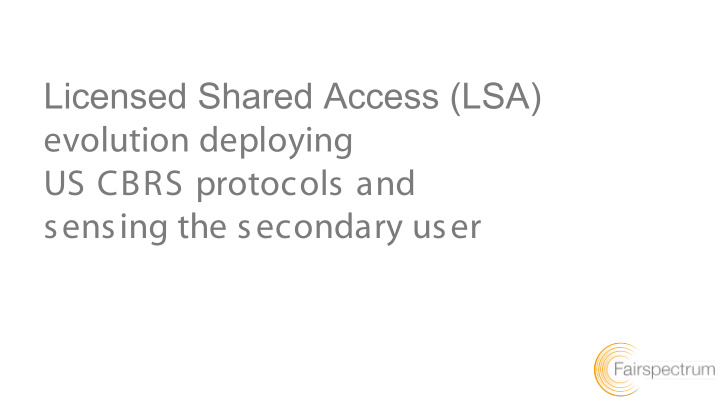



Licensed Shared Access (LSA) evolution deploying US CBRS protocols and sensing the secondary user
Authors Authors Heikki Kokkinen (Fairspectrum, Finland) , Nuno Borges Carvalho (IT Aveiro, Portugal), João Milheiro (IT Aveiro, Portugal), Seppo Yrjölä (Nokia, Finland), Mateus Mazzeo (Nokia, Portugal), Henrique Ribeiro (NOS, Portugal), José Pedro Borrego (ANACOM) Miguel Capela (ANACOM), Sérgio Antunes (ANACOM), José Lopes (SIC, Portugal), (TVI, Portugal), (Altice Portugal), (Vodafone, Portugal), (EMAV, Portugal), (RTP, Portugal)
Background Most spectrum proposals so far either use administrative spectrum assignment information available from the national regulatory authority or carry out sensing in vast areas or at the location of the secondary user.
Fast response The administrative information must be maintained and it may not be well suited to fast response spectrum use.
Man -made obstacles The administrative information based interference protection relies on propagation modeling, and in the current spectrum sharing systems the geographic information does not take into account individual buildings or other large man-made obstacles between the primary and secondary user.
Sensing location Sensing at another location than in the primary user location introduces error compared to the measurement at the primary user receiver antenna.
Low primary power levels Sensing primary user power levels, which are lower or similar as the secondary user power levels, the secondary use may significantly interfere the sensing of the primary signal.
Time perspective Primary Also from time perspective, it is better to decrease the power levels of the secondary users to non- Secondary with sensing the Secondary interfering levels before primary Secondary with sensing the Primary spectrum access begins. Time Potential period of interference with sensing the Primary
All these issues are solved when the sensing takes place at The solution the receiver antenna of the primary user just before the primary use begins.
In this study, the sensing at the primary user location is tested on 2.3 GHz band where a mobile operator is the secondary user and PMSE wireless camera communication is the primary user.
NRA The actual mobile operators, LSA 2 broadcasters, and national regulatory authority participate LSA 3 LSA 1 PMSE LR LC in the pilot setup.
Mobile network A Mobile The mobile network uses network B commercial basestations, core NRA Broadcaster network and network A management system. Spectrum SAS- OAM Manager CBSD Broadcaster B
Protocol methods sm_method_name JSON Array Name of JSON Array Name of Response Request Message Message sensorRegistration sensorRegistrationRequest sensorRegistrationResponse sensorReport sensorReportRequest sensorReportResponse sensorDeregistration sensorDeregistrationRequest sensorDeregistrationResponse
{ "sensorReportRequest": [{ "sensorId": "5695F6BE-092D-41CE-817F- 393F662B6193", "measReport": { "rcvdPowerMeasReports": [{ "nodeName": "LTE_ID_1", "measFrequency": 23000000000, "measBandwidth": 10000000, "measRcvdPower": -21 Sensor Report }, { "nodeName": "LTE_ID_2", "measFrequency": 23010000000, "measBandwidth": 10000000, "measRcvdPower": -21 }] } }] }
{ "sensorReportRequest": [{ "sensorId": "5695F6BE-092D-41CE-817F- 393F662B6193", "measReport": { "rcvdPowerMeasReports": [{ "nodeName": "LTE_ID_1", "measFrequency": 23000000000, "measBandwidth": 10000000, "measRcvdPower": -21 Sensor Report }, { "nodeName": "LTE_ID_2", "measFrequency": 23010000000, "measBandwidth": 10000000, "measRcvdPower": -21 }] } }] }
Future work Future work Summary Summary Sensing secondary user at temporary location of the primary Sensor Report ● Fast response ● Man-made obstacles ● Receiving antenna of the primary
Future work Future work Trials Sensor Report
Recommend
More recommend